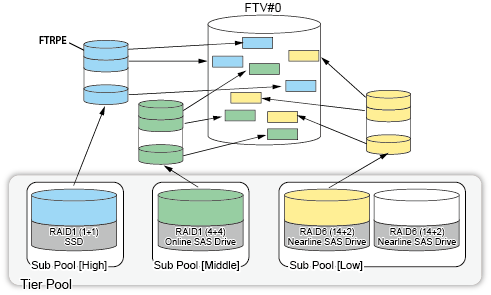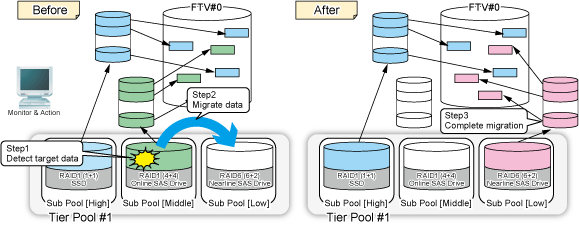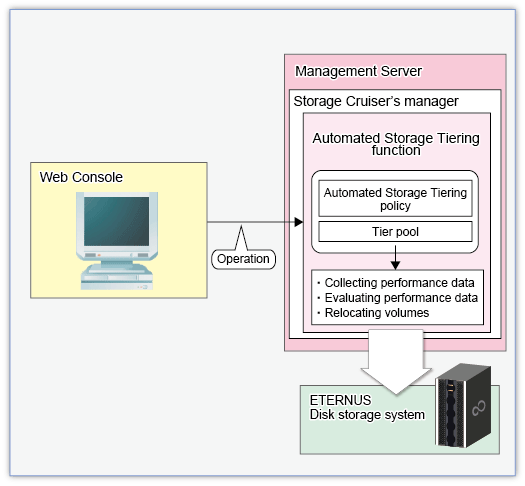Automated Storage Tiering is a function of the storage device wherein, the data is stored in different tiers depending on access metric's. Using this function allows performance and costs to be optimized by storing the data on the appropriate media depending on access characteristic.
The managed pool is referred to as "Tier pool" or "Flexible Tier Pool (FTRP)". The virtual logical volume allocated in the Tier pool is called "Flexible Tier Volume (FTV)".
The Tier pool is configured of sub-pools that are provided with differences in performance. The sub-pool might be called "Flexible Tier Sub Pool (FTSP)".
The sub-pool is configured of assignment units referred to as "Flexible Tier Pool Element (FTRPE)", and the evaluation of access status in order to perform the Automated Storage Tiering is conducted with every FTRPE.
The relation of the FTV, Tier pool, sub-pool, and FTRPE are as illustrated below.
Figure 1.1 Relational Diagram of FTV, Tier pool, Sub-pool, and FTRPE

With Automated Storage Tiering, there are the following methods for the relocation of data within the volume.
No | Method of Data Relocation | Specification of IOPS of Tiering Policies | Specification of FTV Capacity Allocation Ratio | Actions | Characteristics |
|---|---|---|---|---|---|
1 | When you easily use the Automated Storage Tiering | None (omitted value) | Not specified | Relocated in a packed manner from higher positioned sub-pools in order of those with a higher IOPS | Design is easy. Enables maximized utilization of higher positioned sub-pools. |
2 | None (omitted value) | Specified | Relocated according to the capacity assignment rates specified for each sub-pool, in order of those with a higher IOPS | Design is easy. The sub-pool with a high capacity allocation ratio can be maximum used. The performance of each volume can be set in one Tier pool. | |
3 | When you control the Automated Storage Tiering in detail | IOPS Specified | Not specified | Arranged according to the range of thresholds of the IOPS between layer levels | Capable of relocation by IOPS according to operation. Requires design of IOPS. |
Relocation according to the access status is performed in the following manner.
Once Automated Storage Tiering begins in relation to a Tier pool, the access status of each FTRPE is collected each time a predetermined time elapses.
This collection is performed until the evaluation time is reached, for every Evaluation Period, by accumulating the values of the evaluation standard (peak value or average value) of every FTRPE.
At the evaluation time, an evaluation is implemented by using the accumulated data.
By comparing the value of every FTRPE against the ranges configured to the sub-pools, whether to move the data, and the destination sub-pool if the data is to be moved are decided and the relocation is executed.
Relocation according to evaluations and the results of the evaluations is performed either automatically or manually depending on the Execution Mode.
Figure 1.2 Execution Example of Relocation

With this product, the evaluation time, Evaluation Period, evaluation standard, and Execution Mode can be selected as "Tiering policies ".
Refer to "2.1 Tiering Policies" for information on designing the Tiering policy, and "3.4.1 Creation of Tiering Policy" for information on items of the Tiering policy.
By collecting and evaluating access status data from the server, based on Tiering policies, and automatically relocating configuration units of the volume (FTRPE) to the appropriate sub-pool, this product realizes optimized utilization of storage resources.
When an Execution Mode that automatically performs the evaluation and relocation is specified, these will be performed automatically. By dynamically altering the data arrangement even during the operation of tasks, it is possible to correspond to the changes of performance status during the operation of tasks. For this reason, upfront performance estimations and arrangement designs become unnecessary, reducing the work load of task administrators and storage administrators.
When specifying a manual Execution Mode, confirm the access status and execute the evaluation and relocation. Before starting operation of Automated Storage Tiering, it is advised that test runs of evaluation and relocation are performed in order to decide the values for the evaluation time, Evaluation Period, evaluation standard, Execution Mode, and ranges of the sub-pools.
All operations of Automated Storage Tiering can be implemented from the ETERNUS SF Web Console (hereinafter abbreviated as "Web Console").
Figure 1.3 System Configuration

Point
Be sure to perform all operations of Automated Storage Tiering on the same Management Server.
Operation on multiple Management Servers may cause cases where the function does not operate correctly.
Overview of the steps for utilizing the Automated Storage Tiering is as follows:
Setup of Environment
Enable Automated Storage Tiering on storage devices.
Create Tiering policies, Tier pools, and virtual logical volumes (FTVs)
Starting Automated Storage Tiering
Start Automated Storage Tiering for the Tier pool to be used.
(With this operation, the access status data from during the configured period will be collected automatically)
Evaluate the collected access status data and relocate data according to Tiering policies.
(In the Execution Mode where evaluation and relocation are performed automatically, this will be implemented automatically by the system)